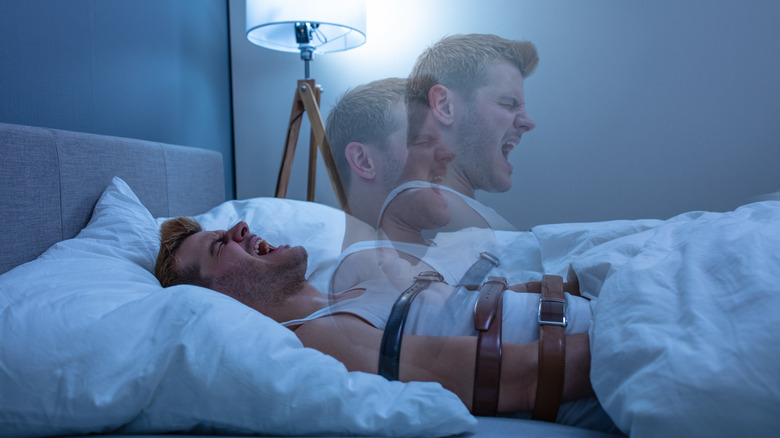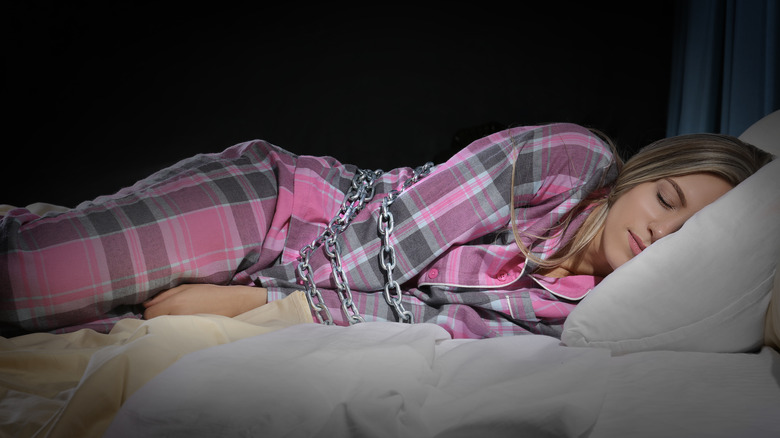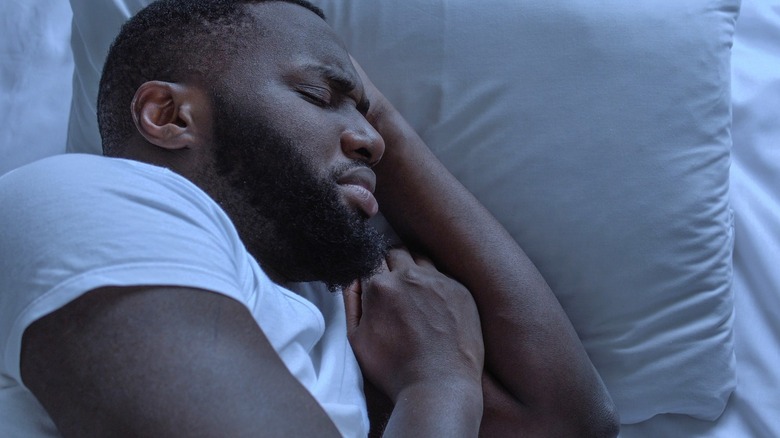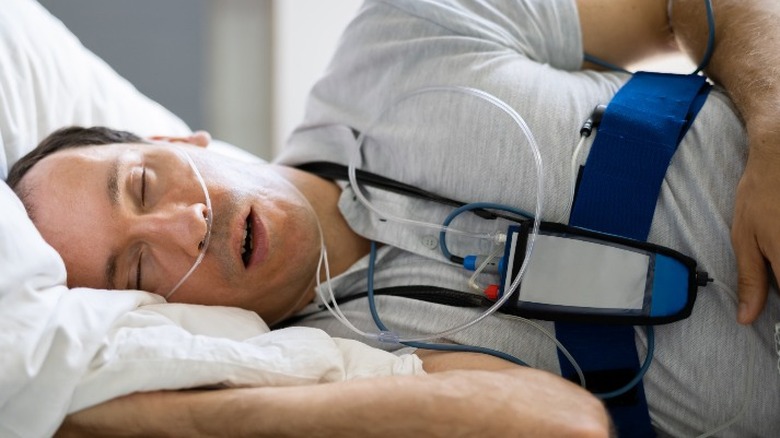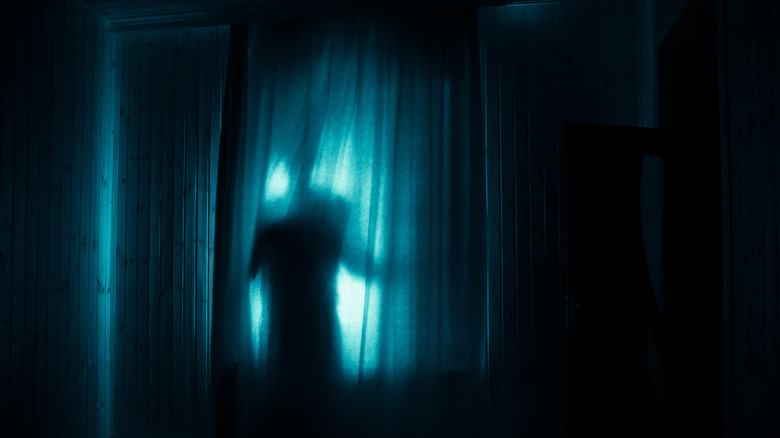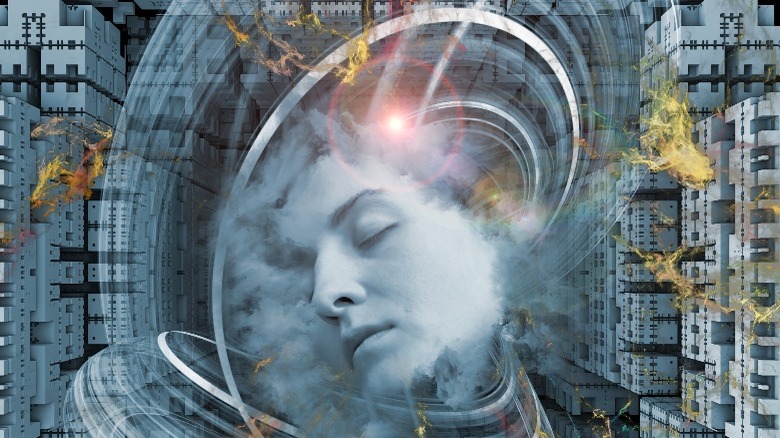What It Really Means When You Experience Sleep Paralysis
Being fully awake without being able to move may sound like the beginning of a horror film, but unfortunately, this horrifying sensation happens in reality. Medically referred to as sleep paralysis, according to The Economic Times, there are two different types of this sleep disorder. If you are awake but unable to move as you're falling asleep—it's called 'hypnagogic' sleep paralysis. For others, this same sensation occurs but while in the process of waking up, which is known as 'hypnopompic' sleep paralysis.
WebMD states that in addition to feeling paralyzed, some people have also reported a feeling of pressure or choking. This disorder is more widespread than people would believe, and most often reveals itself during teenage years. The cause of sleep paralysis may be genetic, but it can also be a side effect of a mental health disorder, substance abuse disorder, or an inconsistent sleep schedule. In addition, "Sleep paralysis is usually brought on by stress, sleep deprivation, and sometimes even alcohol," says chief sleep physiologist Joseph Gannon of the Sleep Disorders Clinic to Bustle.
Sleep paralysis can happen to anyone
Oftentimes, sleep paralysis shows up in those who experience other sleeping disorders such as narcolepsy, but it is important to note that it can happen to anyone. Sleep paralysis can occur frequently, or as an isolated incident. In fact, The Economic Times shares how several studies have shown that many people have at least one episode in their life without ever being aware of it.
So what do you do immediately after you've experienced an episode? Bustle recommends getting out of bed immediately after waking up, turning on a light, and splashing your face with cold water. If you stay in bed and fall back asleep right after you've woken up, you have a higher risk of experiencing sleep paralysis yet again.
As horrifying as the feeling of being temporarily paralyzed is, and knowing that we are all susceptible to it, there is good news. Sleep paralysis doesn't cause any physical harm to the body and is not known to cause death. Should you have any questions or concerns, consider consulting with a physician or sleep specialist to help get you back to peaceful slumbers.
The relationship between sleep paralysis and narcolepsy
According to the Sleep Foundation, narcolepsy can happen to anyone, but most often begins between the ages of 7 and 25. It can either be a stand-alone disorder or it could accompany another sleep disorder, such as insomnia or sleep apnea.
Sleep paralysis happens to around 25% of people with narcolepsy. The connection between sleep paralysis and narcolepsy is believed to be related to the nature and quality of REM sleep patterns. The majority of healthy people enter REM sleep between 60 to 90 minutes after falling asleep. During this REM state, which is the period when you are actively dreaming, your body also experiences a temporary paralysis called atonia. Atonia protects you from acting out your dream while asleep. Atonia typically lifts by the time you wake up. However, those with narcolepsy enter the REM state much sooner after falling asleep, often as quickly as 15 minutes. This throws off natural sleep patterns, and the atonia experienced during the REM state could persist as the person prepares to enter the waking state (via Sleep Foundation).
Testing and diagnosis
If you experience sleep paralysis to the extent that you are too anxious to sleep, then it may be time to discuss the situation with your health care provider. According to the experts at Cleveland Clinic, it is possible to determine whether or not you have sleep paralysis through an evaluation. During an evaluation, your doctor will ask you a variety of questions related to the symptoms you are experiencing, the frequency of your sleep paralysis, how many hours of sleep you typically get, and if you are feeling tired during the day. They will also probably want to know about your medical history, any medications you are taking, if you are suffering from any mental health issues, and if you have any family history of sleep paralysis.
If your doctor suspects that you may have a sleep disorder, they may recommend a sleep test. One kind of test where they could glean more information is through an overnight sleep study, or polysomnogram. As you sleep, the test monitors your heart rate and brain activity, and could provide a clearer picture about the nature of your sleep issue. Another test is the multiple sleep latency test (MSLT), which measures the amount of time it takes you to fall asleep, and the type of sleep you experience during a nap. An MSLT will often uncover conditions, such as narcolepsy, that may be causing your sleep paralysis.
Celebrities who suffer from sleep paralysis
The American Academy of Sleep Medicine (AASM) reports that anywhere between 5 and 40 percent of the population has had sleep paralysis. Celebrities are not immune. Even celebrities who play superheroes do not have the power to fend off sleep paralysis.
According to GQ, actor Tom Holland began experiencing sleep paralysis during his rise to fame. He explains that in one of his common nightmares, he is awake, but he is dreaming that there are paparazzi in his bedroom and flashbulbs are going off. He is confused, he can't move, and is looking for someone to protect him.
"Keeping Up with the Kardashians" star Kendall Jenner revealed her battle with sleep paralysis in a November 2016 episode of the show. Jenner said it feels as though her heart almost stops, and mentioned how scared she was to fall asleep as it was an ongoing, terrifying problem (via US Weekly).
What is a sleep paralysis demon?
Whether or not you're a celebrity, if you are suffering from sleep paralysis, you may find yourself experiencing hallucinations such as sleep paralysis demons. According to the experts at Healthline, sleep paralysis demons can manifest in a variety of ways. Some people may encounter a terrifying being with claws; others describe an alien.
Healthline notes that many cultures have their own ways of explaining sleep paralysis demons. For instance, Japanese folklore describes spirits who try to suffocate people in their sleep in return for a perceived wrongdoing. In Brazil, the demon has a name — Pisadeira — which is Portuguese for "she who steps." Pisadeira comes out at night and waits for just the right chance to land on top of a person's stomach after they have enjoyed a big meal.
Health experts note that these visions are known as hypnagogic or hypnopompic hallucinations.
Hypnagogic and hypnopompic hallucinations explained
According to the experts at Medical News Today, the primary distinction between a hypnagogic and hypnopompic hallucination is that a hypnagogic hallucination takes place as you are falling asleep while a hypnopompic hallucination occurs as you begin to wake up. In other words, these types of hallucinations take place during the transition period between sleep and wakefulness. A hypnagogic or hypnopompic hallucination may occur during sleep paralysis, but even though your body remains still, you may feel as though you are moving, including a sense of falling or flying.
Health experts emphasize, however, that hypnagogic and hypnopompic hallucinations are not the same as the hallucinations experienced by those with psychiatric disorders. The main difference is that those who have hypnagogic or hypnopompic hallucinations typically realize that what they experienced was not real. Also, hypnagogic and hypnopompic hallucinations take place before or after sleep, whereas psychiatric hallucinations can occur at any time (per Aminoff's Neurology and General Medicine).
How to prevent sleep paralysis demons
If you are haunted by sleep paralysis demons or unpleasant hallucinations before or after sleep, sleep disorder specialist Alicia Roth tells the Cleveland Clinic that you have some agency to potentially reduce or eliminate these experiences. For instance, she advises that you look at the kind of television programs you're watching as you prepare to go to bed. Avoid stress by turning off the news by 9 o'clock, and decide a time to close all your social media apps for the night.
In addition, she emphasizes the importance of getting enough sleep and cultivating healthy sleep habits. She also suggests taking a look at your life and discerning if there is an issue with which you are struggling that is showing up in your sleep. Stress and anxiety can interrupt your sleep and contribute to sleep paralysis. Thus, making some adjustments could have a positive impact, and reduce your likelihood of sleep paralysis and hallucinations.

